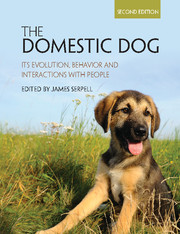Book contents
- Frontmatter
- Dedication
- Contents
- List of contributors
- 1 Introduction
- PART I ORIGINS AND EVOLUTION
- PART II BEHAVIOR, COGNITION AND TRAINING
- PART III DOG-HUMAN INTERACTIONS
- PART IV LIFE ON THE MARGINS
- 16 Variation in dog society: Between resource dispersion and social fl ux
- 17 The ecology and behavior of feral dogs: A case study from central Italy
- 18 Roaming free in the rural idyll: Dogs and their connections with wildlife
- 19 Dog population management
- 20 Epilogue: The tail of the dog
- Index
- Plate section
- References
17 - The ecology and behavior of feral dogs: A case study from central Italy
from PART IV - LIFE ON THE MARGINS
Published online by Cambridge University Press: 30 December 2016
- Frontmatter
- Dedication
- Contents
- List of contributors
- 1 Introduction
- PART I ORIGINS AND EVOLUTION
- PART II BEHAVIOR, COGNITION AND TRAINING
- PART III DOG-HUMAN INTERACTIONS
- PART IV LIFE ON THE MARGINS
- 16 Variation in dog society: Between resource dispersion and social fl ux
- 17 The ecology and behavior of feral dogs: A case study from central Italy
- 18 Roaming free in the rural idyll: Dogs and their connections with wildlife
- 19 Dog population management
- 20 Epilogue: The tail of the dog
- Index
- Plate section
- References
Summary
Feral dogs: A definition
What exactly is a feral dog? Dogs are not a homogeneous category and their immense diversity of phenotypes and functional specializations hinders any unambiguous classification (Boitani et al., 2006). Dog categories have been proposed on the basis of a variety of natural history traits and relationships with humans: behavioral and ecological traits (Causey & Cude, 1980; Scott & Causey, 1973); origins (Daniels & Bekoff, 1989a, 1989b); rural vs. urban habitat (Berman & Dunbar, 1983); access to public property (Beck, 1973), and level of dependency on humans (WHO, 1988). This diversity of definitions contributes to the difficulty of comparing results from different studies, while the great variety of ecological contexts of urban, rural and “natural” habitats means that such comparisons may only yield a confirmation of the high ecological and behavioral flexibility of dogs.
Boitani & Fabbri (1983a), Perry (1993) and Vanak & Gompper (2009) proposed similar classifications based on dogs’ associations with humans. While Perry's categories were functional to his work in managing a rabies control program, Boitani and Fabbri were more interested in the ecology of dog populations in their natural environment. Boitani & Fabbri (1983a) proposed four categories (owned restricted, owned unrestricted, stray and feral dogs) based on the type of social bond with humans, and the ecology of dogs with varying degrees of human dependency. The first two categories are similar to Perry's (1993), i.e. restricted and family dogs. A restricted dog is fully dependent on (all its needs provided intentionally), and also restricted by, humans. Family dogs have an owner on whom they depend, but may be only semi-restricted or left free to roam (Hsu et al., 2003). The third category, stray dogs, is a heterogeneous group that includes dogs that still have a social bond with humans (possibly abandoned or born into human settings), and dogs with different degrees of fear/tolerance towards humans. Stray dogs live near human settings where they find food and shelter regardless of whether these resources are intentionally provided by humans or are causally associated with them (e.g. handouts, refuse tips or garbage dumps for food, structures for shelter, etc.).
- Type
- Chapter
- Information
- The Domestic DogIts Evolution, Behavior and Interactions with People, pp. 342 - 368Publisher: Cambridge University PressPrint publication year: 2016
References
- 13
- Cited by



